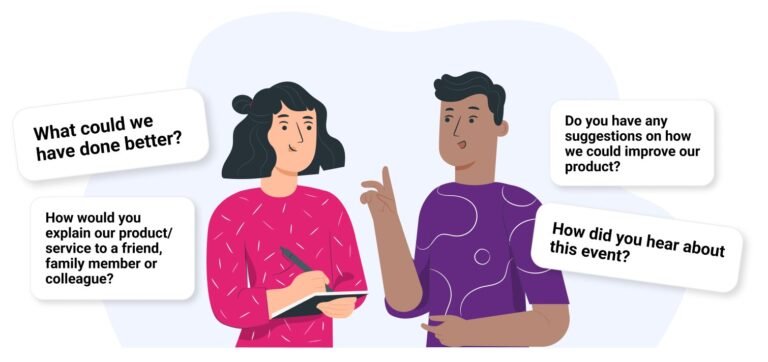Open-ended survey questions are a powerful tool for gathering rich and detailed feedback from your customers, employees, or target audience. Unlike closed-ended questions (an example is the question involving “Yes or No” response), which limit the respondents to predefined choices, open-ended survey questions allow them to express their opinions, feelings, and experiences in their own words.
This can reveal valuable insights that you may not have anticipated or included in your survey options. However, creating effective open-ended survey questions is not as easy as it may seem. You need to consider the purpose, wording, length, and format of your questions, as well as how to analyze and interpret the responses.
This article lists over 100 examples of open-ended survey questions for various domains and scenarios. We will also share some tips and best practices on how to use open-ended survey questions to get the most out of your surveys, as well as how to go about analyzing the results.
Table of contents
- What are Open-Ended Survey Questions?
- Are Open-Ended Survey Questions Qualitative or Quantitative?
- Open-Ended Questions Examples for Survey Research & Feedback Form
- Examples of Open-Ended Questions for Customer Feedback
- Open-Ended Questions for Employee Feedback
- Examples of Open-Ended Questions for Retail
- Open-ended question Examples for Hospitality
- Examples of Open-Ended Questions for eCommerce Surveys
- Open-Ended Survey Questions Examples for Patient Feedback
- Open-ended Questions for Lead Generation
- Examples of Open-Ended Survey Questions for Student Feedback
- Analyzing Open-Ended Survey Questions
- Why Should You Use Open-Ended Questions in Your Survey?
- Tips & Best Practices to Use Open-Ended Survey Questions More Effectively
- FAQs
- Conclusion
- References
- Recommendations
What are Open-Ended Survey Questions?
This type of survey question known as “open-ended survey questions” allows customers to provide their opinions without predefined answer options. These questions are designed to gather information and encourage customers to express their thoughts freely, using sentences, records, or stories.
As the term implies, when customers respond to open-ended survey questions, they have the freedom to share feedback in their own words. Unlike closed-ended questions that offer specific choices, open-ended questions provide a more open platform for diverse responses.
When creating a feedback form, you have the option to include various types of survey questions. This includes both open-ended and closed-ended questions, each having its own set of advantages and disadvantages.
See also: 20 Frequently Asked Microfinance Bank Interview Questions and Answers
Are Open-Ended Survey Questions Qualitative or Quantitative?
Open-ended survey questions are like storytellers—capturing the rich details and personal experiences. They fall into the qualitative category, providing a deeper understanding of thoughts and feelings.
Unlike numbers, they paint a vivid picture, making them qualitative. So, if you want to dive into the “why” and “how” behind responses, open-ended questions are your qualitative guides.
See also: 20 Frequently Asked Facility Management Interview Questions
Open-Ended Questions Examples for Survey Research & Feedback Form
If you want to collect important information and opinions from your audience, incorporating open-ended survey questions into your questionnaires can be a highly effective strategy.
These questions empower respondents to share in-depth and personalized feedback, providing you with a more profound insight into their experiences and viewpoints.
Whether you’re conducting surveys for customer feedback, employee opinions, patient experiences, or student perspectives, consider including some of the following examples of excellent open-ended questions in your surveys:
Examples of Open-Ended Questions for Customer Feedback
Utilizing good open-ended survey questions for gathering customer feedback focuses on grasping the intention behind customers’ purchases. The insights derived from these responses assist brands in making decisions that align with customer interests, ultimately aiming to boost conversions and sales.
Here are a few examples of open-ended survey questions that you can incorporate:
- How would you describe your overall experience with our product/service?
- Can you share a specific moment that exceeded your expectations?
- What features or improvements would make our product/service even better for you?
- In your own words, how did our team handle any challenges you faced?
- Could you elaborate on a situation where our product/service fell short of your expectations?
- What motivated you to choose our product/service over alternatives?
- Can you recall a particularly positive interaction with our customer support team?
- How has our product/service positively impacted your daily life or work?
- Are there any specific areas where you feel we could enhance our communication?
- Can you share a recent instance where our product/service provided a unique solution for you?
- In what ways can we tailor our offerings to better suit your needs?
- Could you describe the key factors influencing your decision to continue using our product/service?
- Is there a specific feature or aspect of our product/service that stands out as particularly valuable to you?
- How would you describe the value for money you receive from our product/service?
- Can you share any suggestions for making our product/service more user-friendly or intuitive?
Open-Ended Questions for Employee Feedback
Workplaces often face unforeseen challenges that employers may not have expected. To tackle this, it is advisable to allow employees to provide feedback using open-ended survey questions.
Consider incorporating the following Open-Ended questions into your employee surveys:
- How would you describe your overall job satisfaction?
- Can you share a recent accomplishment that you’re proud of?
- What aspects of your role do you find most fulfilling?
- In what ways can we support your professional development?
- How do you envision improving teamwork within your department?
- Can you provide insights on work-life balance within our organization?
- What challenges do you foresee in achieving your career goals here?
- Are there specific skills or training you believe would enhance your performance?
- How would you rate communication within our team?
- Can you suggest ways to improve employee morale in the workplace?
- What changes could enhance the efficiency of our current processes?
- In your opinion, what strengths and weaknesses exist in our team dynamics?
- Can you share any ideas for fostering a more inclusive work environment?
- How do you feel about the recognition and rewards system in place?
- Are there any concerns or issues you’d like to address regarding your work experience here?
See also: 100+ Frequently Asked Research Questions About Mental Health with Sample Answers
Examples of Open-Ended Questions for Retail
In the realm of retail survey inquiries, it is vital for success to comprehend customer preferences and enhance the overall shopping experience.
Open-ended survey questions offer a chance to collect valuable insights from customers, enabling informed decision-making aimed at improving their retail experience.
- What factors influence your decision to shop at our store?
- Can you describe a memorable customer service experience you’ve had here?
- How would you improve the layout of our store for better convenience?
- What products or brands would you like to see added to our inventory?
- Can you share a specific instance where our staff exceeded your expectations?
- How would you rate the overall shopping atmosphere in our store?
- In your opinion, what sets our store apart from competitors?
- Can you suggest ways to enhance our online shopping experience?
- What motivated you to make a recent purchase at our store?
- Are there specific promotions or discounts you find most appealing?
- How would you rate the cleanliness and organization of our store?
- Can you share feedback on the checkout process and wait times?
- Are there any particular services you wish our store offered?
- What challenges, if any, have you encountered during your shopping experiences?
- Can you provide insights on the effectiveness of our product displays?
Open-ended question Examples for Hospitality
In the hospitality sector, grasping the requirements and desires of guests is essential for delivering outstanding service.
Introducing open-ended survey questions into your hotel surveys enables establishments to collect valuable insights and make decisions grounded in data, enhancing their services and surpassing guest expectations.
Adopting this customer-centric approach can result in heightened guest satisfaction, positive reviews, and repeat business, ultimately contributing to the hotel’s success.
Consider incorporating the following open-ended questions into your surveys.
- How would you describe your overall experience during your stay?
- Can you recall a specific moment that exceeded your expectations?
- In what ways can we enhance the comfort of your accommodations?
- What factors influenced your choice of our hospitality services?
- Can you share a positive interaction with our staff during your visit?
- How would you rate the variety and quality of our dining options?
- Can you suggest improvements to our guest services or amenities?
- What aspects of our hospitality stood out as particularly enjoyable?
- Can you provide insights on any challenges you faced during your stay?
- How do you feel about the overall ambiance and cleanliness of our facility?
- Can you share any ideas for making our check-in/check-out process smoother?
- What additional services or activities would enhance your experience with us?
- How likely are you to recommend our hospitality services to others?
- Can you describe any specific efforts that made you feel valued as a guest?
- In what ways can we tailor our services to better meet your preferences?
See also: 250+ Best Halloween Trivia Questions for Kids with Answers (Easiest to Hardest)
Examples of Open-Ended Questions for eCommerce Surveys
Survey questions in the realm of eCommerce play a crucial role in obtaining significant insights from customers about their interactions with the online store. These questions can be posed after various events such as a purchase, order delivery, or cart abandonment. Business development managers will benefit from this.
By utilizing open-ended survey questions, businesses can delve into the reasons behind positive or negative experiences, address highlighted issues, and enhance the overall customer experience, leading to increased sales.
- How would you describe your overall shopping experience on our website?
- Can you share a specific feature that made your online shopping convenient?
- In what ways can we improve our website’s user interface?
- What factors influenced your decision to make a recent online purchase?
- Can you provide feedback on our customer support’s responsiveness?
- How would you rate the clarity of product information on our site?
- Can you suggest additional payment options that would enhance your experience?
- What challenges, if any, did you encounter during the online checkout process?
- How likely are you to recommend our eCommerce platform to others?
- Can you share any ideas for promotions or discounts that would appeal to you?
- What improvements can we make to our shipping and delivery services?
- Can you describe a positive interaction with our online customer service team?
- How do you feel about the security and privacy measures on our website?
- Can you suggest ways to enhance the product search and navigation features?
- What additional product categories or brands would you like to see on our site?
Open-Ended Survey Questions Examples for Patient Feedback
In responding to health survey questions, 76% of patients opted to include one or more comments in their questionnaires as revealed by the National Institute of Health. Numerous factors within healthcare impact the quality of medical care, and each patient’s experience is distinct.
Hence, incorporating open-ended survey questions in patient surveys becomes crucial to uncover challenges that might otherwise go unnoticed.
- How would you describe your overall experience with our healthcare services?
- Can you share a specific instance where our medical staff exceeded your expectations?
- In what ways can we improve the comfort and atmosphere of our facilities?
- What factors influenced your choice of our healthcare provider?
- Can you provide feedback on the clarity of information provided about your treatment?
- How would you rate the effectiveness of our communication during your care?
- Can you suggest improvements to streamline the appointment scheduling process?
- What additional services or resources would enhance your patient experience?
- How likely are you to recommend our healthcare facility to others?
- Can you describe any challenges or concerns you encountered during your treatment?
- What aspects of our healthcare services stood out as particularly positive for you?
- Can you share any ideas for educational resources or support for patients?
- How do you feel about the cleanliness and organization of our healthcare facilities?
- Can you suggest ways to enhance the patient check-in/check-out process?
- In what ways can we tailor our services to better meet your healthcare needs?
See also: 250+ Best Anime Trivia Questions and Answers (Easiest to Hardest)
Open-ended Questions for Lead Generation
In lead generation surveys, posing open-ended questions holds significance as it aids brands in gaining deeper insights into potential leads.
This understanding becomes valuable for crafting effective strategies to retarget those leads in case immediate conversion doesn’t occur.
Here are a few instances of open-ended questions suitable for lead-generation surveys:
- What prompted you to explore our products/services?
- Can you describe a specific challenge or goal you’re facing in your business?
- How did you first learn about our company?
- In what ways can we tailor our offerings to better suit your needs?
- Can you elaborate on your current decision-making process for choosing a solution?
- What specific features or benefits are you looking for in a product/service?
- Can you share any past experiences with similar products/services?
- How do you envision our solution addressing your unique requirements?
- What factors influence your timeline for making a purchase decision?
- Can you provide insights into your budget considerations for this solution?
- What challenges, if any, have you encountered in your current setup?
- Can you describe your ideal outcome or goal in adopting a new solution?
- How would you prioritize the importance of various features in a solution?
- Can you share any concerns or hesitations you may have about our product/service?
- In what ways can our team support you throughout the decision-making process?
Examples of Open-Ended Survey Questions for Student Feedback
In colleges and universities, many students may not only wish to share their thoughts on various aspects such as courses, faculty, campus facilities, scholarships, or Pell Grants but may also possess valuable suggestions to enhance academic standards and the overall campus atmosphere.
To encourage candid student feedback, consider posing the following open-ended survey questions:
- How would you describe your overall learning experience in this course?
- Can you share a specific aspect of the class that you found particularly engaging?
- In what ways can we improve the clarity of course materials and instructions?
- What factors influenced your decision to enroll in this program or course?
- Can you provide insights into your preferred learning style and preferences?
- How would you rate the effectiveness of communication from instructors and staff?
- Can you suggest improvements to enhance the online learning platform or tools?
- What additional resources or support would enhance your academic experience?
- How likely are you to recommend this course or program to your peers?
- Can you describe any challenges or concerns you encountered during your studies?
- What aspects of the course stood out as particularly positive for you?
- Can you share any ideas for extracurricular activities or student engagement?
- How do you feel about the assessment methods and feedback provided?
- Can you suggest ways to improve the student registration and enrollment process?
- In what ways can we tailor our educational services to better meet your needs?
See also: 250+ Best Math Trivia Questions and Answers (Easiest to Hardest)
Analyzing Open-Ended Survey Questions
Doing the analysis of open-ended survey questions is like decoding messages from friends.
First, read through the responses to understand the main ideas. Look for patterns, grouping similar answers. It’s like sorting puzzle pieces!
Next, categorize the comments based on common themes, creating a clear picture. Think of it as organizing thoughts into folders.
After grouping, identify any trends or recurring sentiments. Imagine these trends as the heartbeat of your feedback.
Lastly, summarize your findings, turning complex ideas into simple takeaways.
Analyzing open-ended questions is a bit like storytelling – you uncover the narrative within the responses, making the process both insightful and approachable.
See also: 250+ Best Holiday Trivia Questions and Answers (Easiest to Hardest)
Why Should You Use Open-Ended Questions in Your Survey?
Consider incorporating open-ended survey questions into your feedback surveys for the following reasons:
#1. Get Detailed Information
Occasionally, the responses from your participants may lack the depth needed to draw meaningful conclusions.
For instance, if a customer rates your brand poorly, the specific reason might remain unclear unless you directly inquire about it. This issue can be addressed through the inclusion of open-ended survey questions.
Furthermore, open-ended questions offer an opportunity to obtain elaborate responses on specific aspects, such as your customer’s experience with a recently launched product or service.
#2. Empower Respondents
While focusing on quantitative data for analysis is common for product or service providers, it may overlook the importance of conveying to customers that their opinions truly matter.
Open-ended survey questions provide a platform for customers to freely express their thoughts, emphasizing their experiences rather than just numerical data. This approach can empower customers, making them feel genuinely heard and valued.
See also: 20+ Frequently Asked PTDF Interview Questions
#3. Obtain Qualitative Data
A survey employing closed-ended questions yields quantitative results, while the use of open-ended survey questions facilitates the collection of qualitative data. This approach enables not only the measurement of respondents’ satisfaction or loyalty to a brand but also the capture of their diverse viewpoints, varied perceptions, and genuine opinions. This, in turn, provides valuable insights that can drive more significant positive changes.
Consider a scenario where a patient expresses satisfaction with the care received at a hospital but encounters difficulty in scheduling appointments online. Through an open-ended question, the patient can highlight this issue, prompting the healthcare facility to address the concern by developing a website to enhance the ease of appointment bookings for patients.
#4. Capture an Infinite Range of Answers
In contrast to closed-ended questions, open-ended survey questions don’t impose restrictions on responses. This allows customers or respondents to provide unexpected answers that may offer valuable insights.
For instance, a retail store survey may gather feedback on product quality, customer service, and return policies. However, through a single open-ended question, customers can bring attention to issues that might typically escape notice, such as inadequate parking or a lack of self-service options.
#5. Improve Customer Satisfaction
In certain situations, relying solely on quantitative data may fall short in guiding crucial decision-making. However, by incorporating open-ended survey questions into your customer satisfaction surveys, you gain insights into your customers’ preferences, likes, and needs.
This understanding paves the way for innovation and improvement that directly aligns with their expectations. When utilized effectively, open-ended questions have the potential to significantly enhance customer satisfaction.
See also: 250+ Best Geography Trivia Questions and Answers (Easiest to Hardest)
Tips & Best Practices to Use Open-Ended Survey Questions More Effectively
Surprisingly, relying solely on open-ended questions may have a detrimental impact on your survey response rates.
To ensure a balance between ease of participation for respondents and the quality of responses, it is essential to incorporate a combination of closed-ended questions and open-ended survey questions.
This approach optimizes the survey-taking experience, encouraging higher response rates without compromising the depth and quality of the feedback received.
- Categorize all potential answers into groups for respondents to choose from.
- To encourage participants to share their experiences with your brand, include an open-ended survey question towards the survey’s conclusion.
- Reiterate or rephrase their responses to demonstrate engagement and confirm understanding, fostering further elaboration.
- Strike a balance between open-ended and closed-ended questions for a structured yet expressive survey format.
- Strategically place open-ended questions, as starting with them prompts participants to delve deeper into the topic early on.
- While open-ended questions are valuable, use them judiciously to avoid overwhelming respondents. Prioritize the most crucial aspects.
- For broader surveys, consider categorizing open-ended responses based on demographics or other pertinent factors for nuanced analysis.
- Be prepared for the qualitative data and sentiment analysis phase. Coding or categorizing responses aids in identifying patterns and themes.
See also: 250+ Best Christmas Trivia for Kids Questions and Answers (Easiest to Hardest)
FAQs
An open-ended survey question is a question that allows respondents to answer in their own words. Questions like these can be used to gather qualitative data about people’s opinions, perceptions, and experiences.
For example, if you have a closed question like – “Do you think the product was efficient?” with the options “Yes” and “No”, you can follow it up with an open question like “How do you think we can make the product better in future?” Regarding surveys, the advantages of open questions surpass that of closed ones.
It is recommended that you use only three to five open-ended questions in your survey to increase participation. Another good rule of thumb is to only create open-ended questions when using a multiple-choice format would not suffice.
Many statisticians concur that a sample size of 100 is the minimum you need for meaningful results. If your population is smaller than that, you should aim to survey all of the members. The same source states that the maximum number of respondents should be 10% of your population, but it should not exceed 1000.
One of the main disadvantages of open-ended questions is that it takes time for the customers to write feedback in their own words.
Conclusion
If you aim to gain precise customer insights into their feelings, attitudes, and perspectives regarding your products, services, and organization, effective open-ended survey questions can play a role similar to how line managers use open questions to encourage team members to share openly.
However, if your goal is to swiftly collect quantitative statistics on customer feedback, relying solely on open-ended questions may not be the most efficient choice. An optimal survey design involves a balanced combination of both open-ended and closed-ended questions.
References
- Zonkafeedback.com – Open-Ended Questions: Examples, Benefits, and Best Practices
- Hotjar.com – How to analyze Open-Ended questions in 5 steps [template included]
Recommendations
- 250+ Best Game of Thrones Trivia Questions and Answers (Easiest to Hardest)
- 120+ Fun Team Trivia Questions & Answers For Team Building
- 250+ Best St Patrick’s Day Trivia Questions and Answers (Easiest to Hardest)
- 250+ Best Greek Mythology Vacation Trivia Questions and Answers (Easiest to Hardest)
- 250+ Best Memorial Day Trivia Questions and Answers (Easiest to Hardest)





